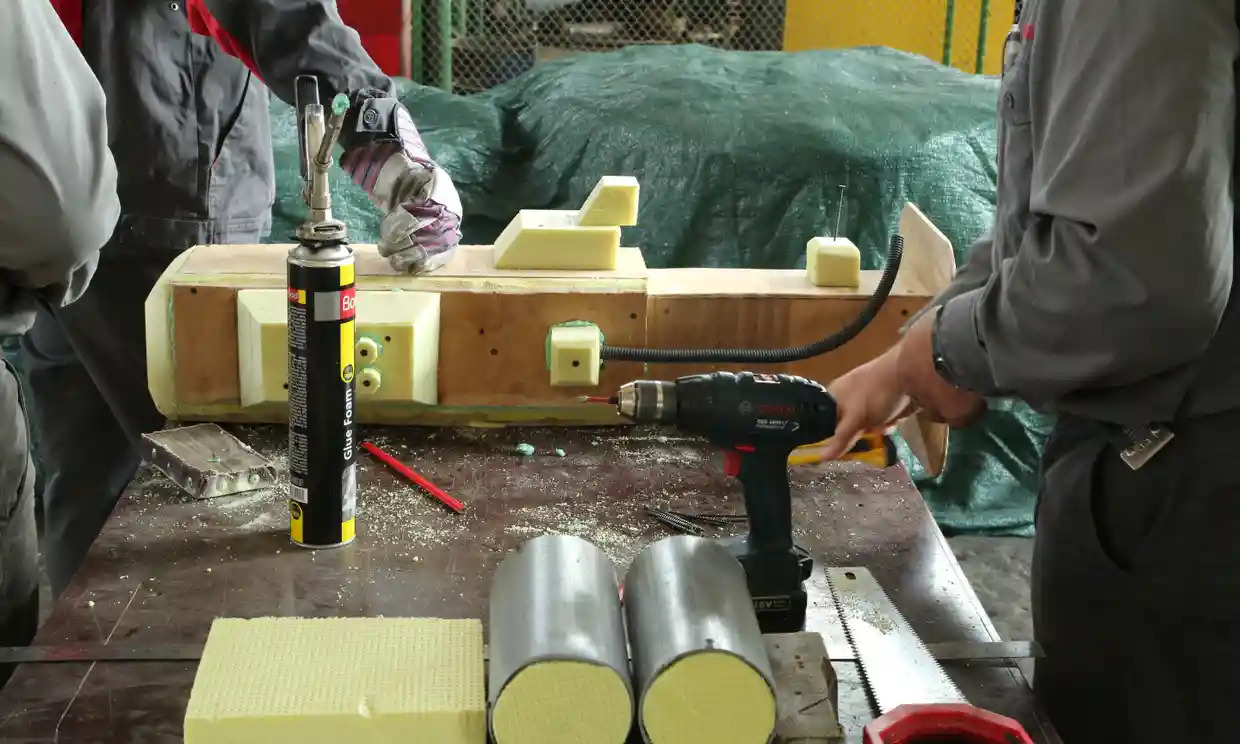In a dusty workshop, a unique group of Ukrainian weapons experts race to produce artillery guns that will never be fired, radar trucks that cannot detect anything, and missiles without explosives.
The pieces are decoys that aim to draw Russian fire, wasting enemy ammunition, missiles and drones while protecting real equipment and the soldiers manning it.
The team’s skill, honed over more than a year, is shaping plastic, scrap wood, foam and metal into copies of advanced weapon systems, precise enough to convince Russian operators of drone cameras and battle-seasoned troops on the ground that they are real military targets.
They measure success by how quickly their products are destroyed. “When the military come to us and says ‘we are out of these’, it means we were totally successful in our job,” says one.
A cupboard near their workshop is stuffed with expensive souvenirs of that success, including the engine and crumpled fragments of an Iranian-made Shahed suicide drone and the crashed wing of a Russian-made Lancet loitering drone, both lured to attack the fake equipment.
Hitting a decoy is a costly mistake for Russia, and also means one less attack on a real Ukrainian position. “These can save the lives of our guys, our friends who are serving,” the worker adds. “We have an agreement with the military to share pictures and remains of attacks (on decoys), as proof we did a good job.”

The team uses plastic, scrap wood, foam and metal to produce copies of advanced weapon systems. Photograph: Oleg Solokha for the Guardian
The Guardian are the first journalists allowed to see the workshop and interview the team, a meeting arranged on condition the men and their location are not identified.
All of them are employees of steel company Metinvest, which ran the Azovstal steelworks in Mariupol. The siege of that plant last spring became emblematic of Russian brutality.
Three senior managers at the firm came up with the idea of making decoy weapons at the start of the war, when Ukraine’s troops seemed dangerously outgunned. The influx of western weaponry that has helped hold Russia at bay had only just begun flowing across the border.
“We thought if the Russians saw a lot of weapons, they might be scared to move forward, or to shell an area. It’s a psychological weapon,” says one of them. “The company fully supported it.”
Metinvest’s main shareholder is Ukraine’s richest man, Rinat Akhmetov, who has backed the decoy project personally, a spokesperson said.
The team is all volunteers, drawn from the payroll before February 2022. This ensures confidence in a group whose project makes them a target. “We have to be able to trust each other, we didn’t just hire people off the streets. We know these guys,” one says.
They are regularly updating their “production line” to mimic new arrivals into Ukraine’s fast-expanding arsenal and make more realistic models. “At the beginning of the war it was very simple, the Russians would see something and try to hit it.”
With both sides using decoys – Ukraine’s military has mocked Russia for deploying inflatable tanks that deflated in position – Russians now do more reconnaissance to check out sightings, but the team believe their designs can stay one step ahead.
Lately that has included tricks to mimic the heat of real weapons systems, so the models are convincing not just in daylight, but at night when observed through thermal image sights.
“The enemy is not stupid. We have to adapt to reality, we always add something new in our work. And we assess ourselves this way – if nothing happens when we send out a new model, if it isn’t targeted, we got something wrong in the design.”
Requests from the military arrive in encrypted messages. A recent brief exchange seen by the Guardian went: “Could you try to do this? We want 50 units.”
The Metinvest designer said yes, and set his team to work. The first stop is Google, to download more images of the equipment they are recreating, then they brainstorm about scrap or cheap materials that would look convincing under camouflage paint. They have used everything from sewage pipes to discarded wooden packaging and old oil drums.
When they finally set to work, large-scale printouts of the weapons systems are taped up as a guide to workers, who make carefully measured stencils for each part, down to wheel nuts on vehicles transporting “weapons”.
The finished decoys are easily transported, in flatpack form, for assembly on the frontline, where an “artillery gun” can be put together in only 20 minutes.

Handouts showing mock-ups of a howitzer and a radar
None of the team have a background in theatre or set design, but their craftmanship is immaculate. They believe their creations are superior to inflatable decoys also being manufactured for Ukrainian troops. A metal spine to most creations means they can also be repaired after a partial hit, unlike the inflatables.
“The military have told us there are some problems with these in the wind or certain weather conditions, they can get blown around and don’t look real.”
Decoys and deception have a history almost as long as warfare itself. One of the earliest examples, the Trojan horse, has made it into English dictionaries as shorthand for something “intended secretly to undermine or bring about the downfall of an enemy”.
Blow-up tanks were first deployed to great effect by allied forces during the second world war. In that conflict the US fielded an entire “ghost army” division, the 23rd Headquarters Special Troops, which also used sound effects, false radio signals and an array of other illusions to mimic large troop movements.
Of course, the Ukrainian decoy team are eager to do themselves out of a job – “we are looking forward to victory, and to get rid of this work”, they say.
